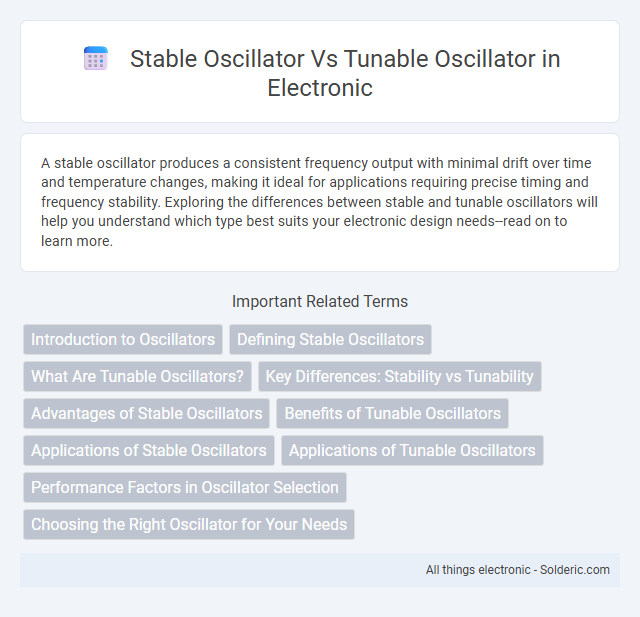A stable oscillator produces a consistent frequency output with minimal drift over time and temperature changes, making it ideal for applications requiring precise timing and frequency stability. Exploring the differences between stable and tunable oscillators will help you understand which type best suits your electronic design needs--read on to learn more.
Comparison Table
| Feature | Stable Oscillator | Tunable Oscillator |
|---|---|---|
| Frequency Stability | High stability, minimal drift | Variable stability, depends on tuning method |
| Frequency Range | Fixed frequency or narrow range | Wide adjustable frequency range |
| Applications | Clocks, references, communication systems | Signal generators, radios, frequency synthesizers |
| Tuning Mechanism | None or limited tuning | Mechanical, electronic (varactor, PLL) |
| Complexity | Simple design for optimal stability | More complex due to tuning circuitry |
| Cost | Moderate to high for precision components | Variable; generally higher due to tunability |
Introduction to Oscillators
Oscillators generate continuous waveforms essential for electronic circuits, with stable oscillators maintaining a fixed frequency for precise timing applications. Tunable oscillators allow frequency adjustment, enabling flexibility in communication systems and signal processing. Your choice between stable and tunable oscillators depends on the need for either consistent signal stability or adaptable frequency control.
Defining Stable Oscillators
Stable oscillators maintain a consistent frequency over time, minimizing drift caused by temperature changes, power supply variations, or aging components. Common examples include crystal oscillators and oven-controlled crystal oscillators (OCXOs), which are essential in applications requiring precise timing such as GPS systems and communication networks. Your choice of a stable oscillator ensures reliability and accuracy in frequency-dependent electronic circuits.
What Are Tunable Oscillators?
Tunable oscillators are electronic circuits designed to adjust their output frequency within a specific range, allowing for greater flexibility in signal generation compared to stable oscillators fixed at a single frequency. These devices utilize components such as varactors or voltage-controlled elements to shift frequency output, making them essential in applications like radio transmitters, frequency synthesizers, and communication systems. Understanding the functionality of tunable oscillators can help you optimize your designs for dynamic frequency control and improved performance.
Key Differences: Stability vs Tunability
Stable oscillators provide consistent frequency output with minimal variation over time and environmental changes, making them ideal for applications requiring precise and reliable signals. Tunable oscillators offer adjustable frequency ranges, allowing customization to specific needs but often sacrificing some degree of stability for flexibility. Your choice depends on whether consistent signal integrity or frequency adaptability is more critical for your project.
Advantages of Stable Oscillators
Stable oscillators provide consistent frequency output with minimal drift over time and temperature variations, making them ideal for applications requiring high precision and reliability. Their inherent stability reduces the need for frequent recalibration, enhancing system performance and minimizing maintenance costs. Your designs benefit from stable oscillators when long-term signal integrity and accuracy are critical.
Benefits of Tunable Oscillators
Tunable oscillators offer the significant benefit of frequency flexibility, allowing you to adjust the output frequency to meet varying application requirements, such as in communication systems and signal processing. They enable precise frequency control, which is essential for adaptive systems and multi-band devices, enhancing overall performance and versatility. Compared to stable oscillators with fixed frequencies, tunable oscillators provide greater customization, supporting dynamic environments and reducing the need for multiple separate components.
Applications of Stable Oscillators
Stable oscillators are essential in applications requiring precise frequency control, such as in communication systems, GPS devices, and timing circuits for digital electronics. Their consistent frequency output ensures reliable signal processing, minimizing errors in data transmission and synchronization tasks. Your designs benefit from stable oscillators when accuracy and long-term frequency stability are critical.
Applications of Tunable Oscillators
Tunable oscillators are essential in applications where frequency agility is required, such as in wireless communication systems, signal generation, and electronic test equipment. These oscillators enable precise control over the output frequency, making them ideal for frequency synthesis in radio transmitters and receivers. Your devices benefit from tunable oscillators when adaptive frequency tuning or multi-band operation is necessary for optimized performance.
Performance Factors in Oscillator Selection
Stable oscillators offer superior frequency accuracy and low phase noise, essential for applications requiring precise signal generation and minimal jitter. Tunable oscillators provide flexibility in frequency adjustment but may exhibit higher phase noise and lower stability under varying environmental conditions. Your choice depends on whether consistent performance or frequency adaptability is the priority in your oscillator selection.
Choosing the Right Oscillator for Your Needs
Choosing the right oscillator depends on your application's precision and flexibility requirements. Stable oscillators provide fixed-frequency signals with high accuracy and low phase noise, making them ideal for timing-critical systems like clocks and communication devices. Tunable oscillators offer adjustable frequencies suitable for versatile applications requiring dynamic signal generation, allowing you to tailor performance to specific needs without compromising stability.
Stable oscillator vs Tunable oscillator Infographic

 solderic.com
solderic.com